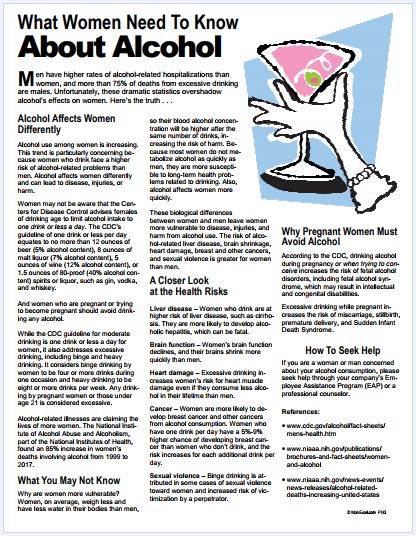- Home
- What Women Need to Know about Alcohol
What Women Need to Know about Alcohol
What Women Need to Know about Alcohol
Free Download
Men have higher rates of alcohol-related hospitalizations than women, and more than 75% of deaths from excessive drinking are males.
 Unfortunately, these dramatic statistics overshadow alcohol’s effects on women. Here’s the truth . . .
Unfortunately, these dramatic statistics overshadow alcohol’s effects on women. Here’s the truth . . .
+++++++++++++++++++++++++++++
DOWNLOAD THE REPRODUCIBLE AND EDITABLE TIP SHEET HERE
DOWNLOAD THE PDF ONLY HERE (INSTEAD OF THE ZIP PKG.)
+++++++++++++++++++++++++++++
Alcohol Affects Women Differently
Alcohol use among women is increasing. This trend is particularly concerning because women who drink face a higher risk of alcohol-related problems than men. Alcohol affects women differently and can lead to disease, injuries, or harm.
Women may not be aware that the Centers for Disease Control advises females of drinking age to limit alcohol intake to one drink or less a day. The CDC’s guideline of one drink or less per day equates to no more than 12 ounces of beer (5% alcohol content), 8 ounces of malt liquor (7% alcohol content), 5 ounces of wine (12% alcohol content), or 1.5 ounces of 80-proof (40% alcohol content) spirits or liquor, such as gin, vodka, and whiskey.
And women who are pregnant or trying to become pregnant should avoid drinking any alcohol.
While the CDC guideline for moderate drinking is one drink or less a day for women, it also addresses excessive drinking, including binge and heavy drinking. It considers binge drinking by women to be four or more drinks during one occasion and heavy drinking to be eight or more drinks per week. Any drinking by pregnant women or those under age 21 is considered excessive.
Alcohol-related illnesses are claiming the lives of more women. The National Institute of Alcohol Abuse and Alcoholism, part of the National Institutes of Health, found an 85% increase in women’s deaths involving alcohol from 1999 to 2017.
What You May Not Know
Why are women more vulnerable? Women, on average, weigh less and have less water in their bodies than men, so their blood alcohol concentration will be higher after the same number of drinks, increasing the risk of harm. Because most women do not metabolize alcohol as quickly as men, they are more susceptible to long-term health problems related to drinking. Also, alcohol affects women more quickly.
These biological differences between women and men leave women more vulnerable to disease, injuries, and harm from alcohol use. The risk of alcohol-related liver disease, brain shrinkage, heart damage, breast and other cancers, and sexual violence is greater for women than men.
A Closer Look at the Health Risks
Liver disease – Women who drink are at higher risk of liver disease, such as cirrhosis. They are more likely to develop alcoholic hepatitis, which can be fatal.
Brain function – Women’s brain function declines, and their brains shrink more quickly than men.
Heart damage – Excessive drinking increases women’s risk for heart muscle damage even if they consume less alcohol in their lifetime than men.
Cancer – Women are more likely to develop breast cancer and other cancers from alcohol consumption. Women who have one drink per day have a 5%-9% higher chance of developing breast cancer than women who don’t drink, and the risk increases for each additional drink per day.
Sexual violence – Binge drinking is attributed in some cases of sexual violence toward women and increased risk of victimization by a perpetrator.
Why Pregnant Women Must Avoid Alcohol
According to the CDC, drinking alcohol during pregnancy or when trying to conceive increases the risk of fetal alcohol disorders, including fetal alcohol syndrome, which may result in intellectual and congenital disabilities.
Excessive drinking while pregnant increases the risk of miscarriage, stillbirth, premature delivery, and Sudden Infant Death Syndrome.
How To Seek Help
If you are a woman or man concerned about your alcohol consumption, please seek help through your company’s Employee Assistance Program (EAP) or a professional counselor.
==============================================
See the PowerPoint (also available as video or self-contained Web Course Full preview below.)
The Editable and Brandable, Free Tip Sheet Is Above. Click here for the media product:
Learn More About EAP Resources
PowerPoint and Products for this Tip Sheet
Drug and Alcohol Training for Employees
Drug and Alcohol Training for Supervisors
Get a free trial and information about Frontline Employee EAP Newsletter
 Loading... Please wait...
Loading... Please wait...

